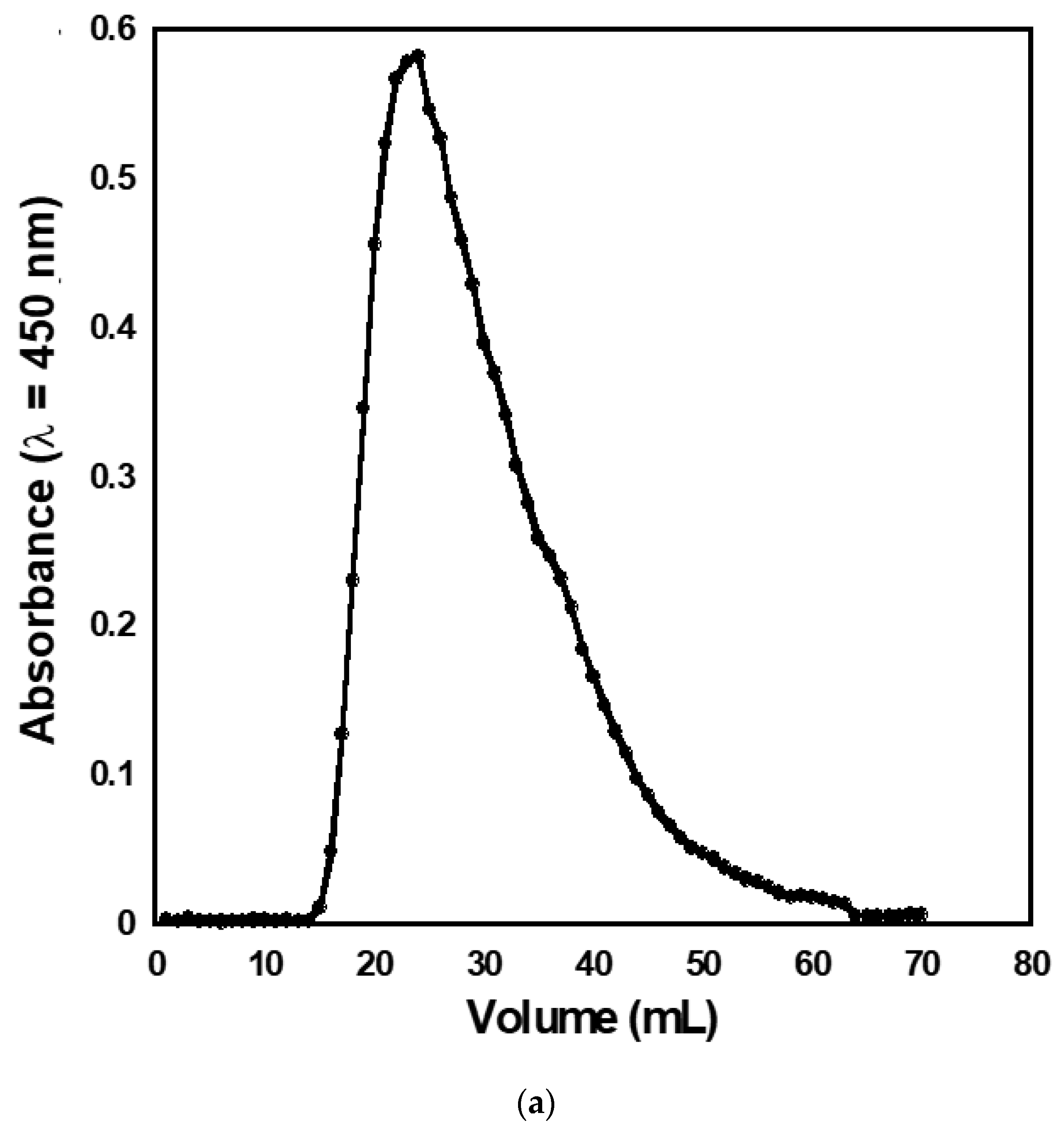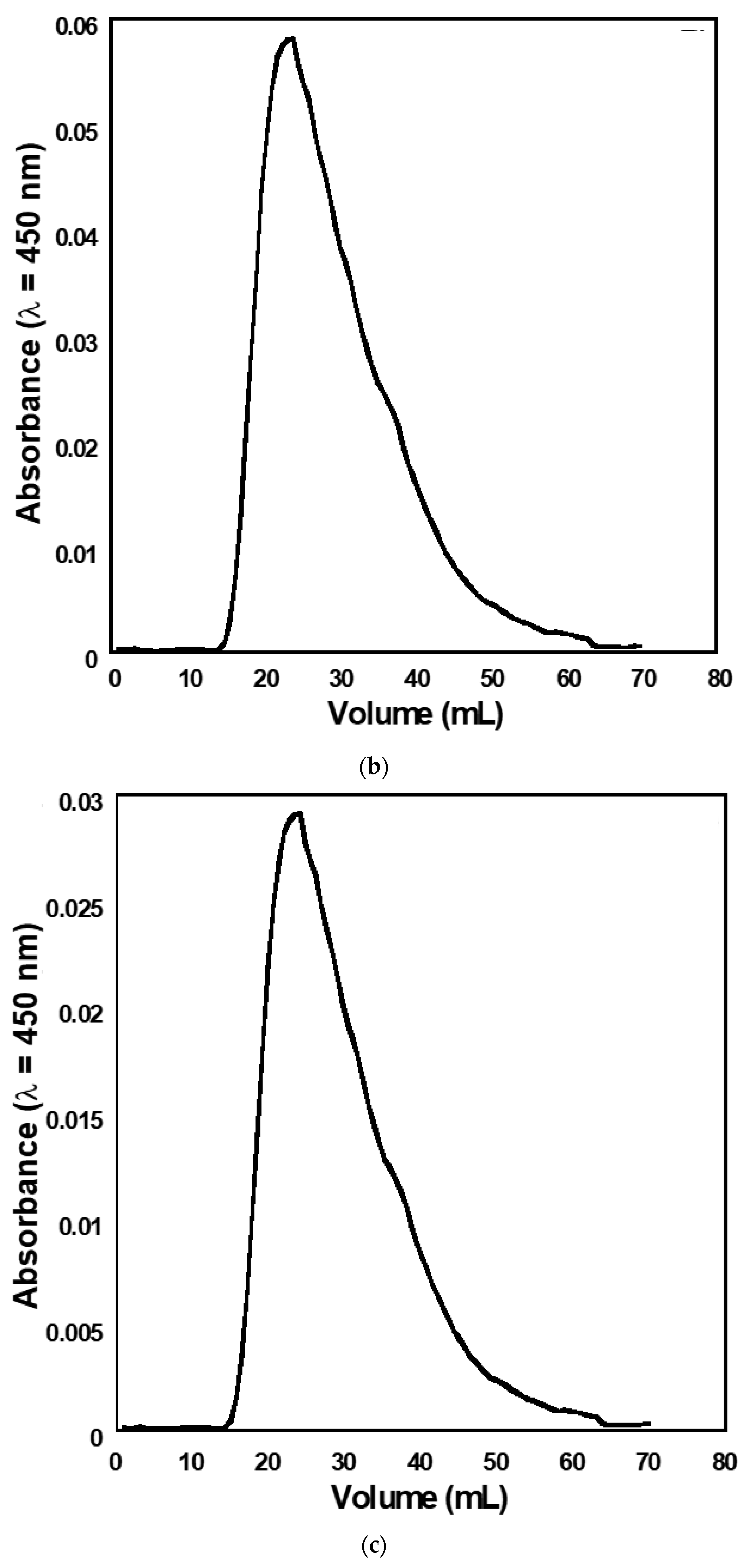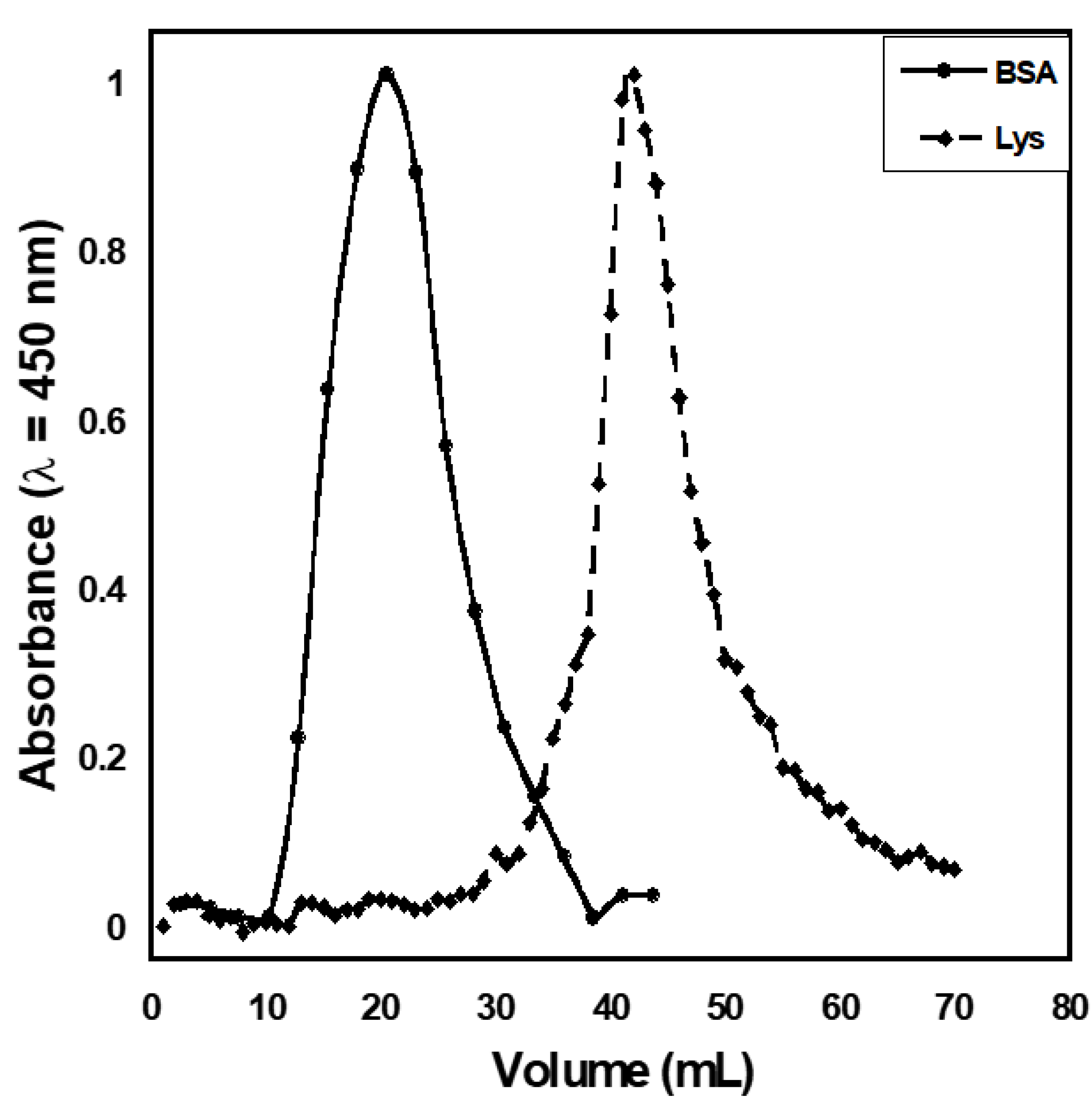Macromolecular Structure of a Commercial Humic Acid Sample
Abstract
:1. Introduction
2. Materials and Methods
2.1. Humic Acids (HA) Sample
2.2. Dialysis Experiments
2.3. Low-Pressure Size-Exclusion Chromatography (LP-SEC)
3. Results and Discussion
3.1. Membrane Dialysis Experiments (MD)
3.2. Size-Exclusion Chromatography (SEC)
4. Conclusions
Author Contributions
Funding
Acknowledgments
Conflicts of Interest
References
- Stevenson, F.J. Humus Chemistry: Genesis, Composition and Reactions; John Wiley & Sons: Hoboken, NJ, USA, 1994. [Google Scholar]
- Wang, S.; Mulligan, C.N. Effect of natural organic matter on arsenic release from soils and sediments into groundwater. Environ. Geochem. Health 2006, 28, 197–214. [Google Scholar] [CrossRef] [PubMed]
- Leone, V.; Canzano, S.; Iovino, P.; Capasso, S. Sorption of humic acids by a zeolite-feldspar-bearing tuff in batch and fixed-bed column. J. Porous Mater. 2012, 19, 449–453. [Google Scholar] [CrossRef]
- Iovino, P.; Leone, V.; Salvestrini, S.; Capasso, S. Sorption of non-ionic organic pollutants onto immobilized humic acid. Desalin. Water Treat. 2015, 56, 55–62. [Google Scholar] [CrossRef]
- Chianese, S.; Fenti, A.; Iovino, P.; Musmarra, D.; Salvestrini, S. Sorption of Organic Pollutants by Humic Acids: A Review. Molecules 2020, 25, 918. [Google Scholar] [CrossRef] [Green Version]
- Leone, V.; Canzano, S.; Iovino, P.; Salvestrini, S.; Capasso, S. A novel organo-zeolite adduct for environmental applications: Sorption of phenol. Chemosphere 2013, 91, 415–420. [Google Scholar] [CrossRef]
- Perminova, I.V.; Hatfield, K. Remediation Chemistry of Humic Substances: Theory and Implications for Technology. In Use of Humic Substances to Remediate Polluted Environments: From Theory to Practice; Springer: Amsterdam, The Netherlands, 2005; pp. 3–36. [Google Scholar]
- Canzano, S.; Capasso, S.; Di Natale, M.; Erto, A.; Iovino, P.; Musmarra, D. Remediation of groundwater polluted by aromatic compounds by means of adsorption. Sustainability 2014, 6, 4807–4822. [Google Scholar] [CrossRef] [Green Version]
- Santonastaso, G.F.F.; Erto, A.; Bortone, I.; Chianese, S.; Di Nardo, A.; Musmarra, D. Experimental and simulation study of the restoration of a thallium (I)-contaminated aquifer by Permeable Adsorptive Barriers (PABs). Sci. Total Environ. 2018, 630, 62–71. [Google Scholar] [CrossRef] [Green Version]
- Iovino, P.; Chianese, S.; Canzano, S.; Prisciandaro, M.; Musmarra, D. Ibuprofen photodegradation in aqueous solutions. Environ. Sci. Pollut. Res. 2016. [Google Scholar] [CrossRef]
- Iovino, P.; Chianese, S.; Canzano, S.; Prisciandaro, M.; Musmarra, D. Degradation of Ibuprofen in Aqueous Solution with UV Light: The Effect of Reactor Volume and pH. Water Air. Soil Pollut. 2016, 227, 194. [Google Scholar] [CrossRef]
- Jones, M.N.; Bryan, N.D. Colloidal properties of humic substances. Adv. Colloid Interface Sci. 1998, 78, 1–48. [Google Scholar] [CrossRef]
- Tan, L.; Tan, X.; Mei, H.; Ai, Y.; Sun, L.; Zhao, G.; Hayat, T.; Alsaedi, A.; Chen, C.; Wang, X. Coagulation behavior of humic acid in aqueous solutions containing Cs+, Sr2+ and Eu3+: DLS, EEM and MD simulations. Environ. Pollut. 2018, 236, 835–843. [Google Scholar] [CrossRef] [PubMed]
- Guetzloff, T.F.; Rice, J.A. Does humic acid form a micelle? Sci. Total Environ. 1994, 152, 31–35. [Google Scholar] [CrossRef]
- Šmejkalová, D.; Piccolo, A. Host-guest interactions between 2,4-dichlorophenol and humic substances as evaluated by 1H NMR relaxation and diffusion ordered spectroscopy. Environ. Sci. Technol. 2008, 42, 8440–8445. [Google Scholar] [CrossRef] [PubMed]
- Piccolo, A. The supramolecular structure of humic substances. Soil Sci. 2001, 166, 810–832. [Google Scholar] [CrossRef] [Green Version]
- von Wandruszka, R. Humic acids: Their detergent qualities and potential uses in pollution remediation. Geochem. Trans. 2000, 1, 10. [Google Scholar] [CrossRef]
- Baigorri, R.; Fuentes, M.; González-Gaitano, G.; García-Mina, J.M. Simultaneous presence of diverse molecular patterns in humic substances in solution. J. Phys. Chem. B 2007, 111, 10577–10582. [Google Scholar] [CrossRef]
- Maia, C.M.B.F.; Piccolo, A.; Mangrich, A.S. Molecular size distribution of compost-derived humates as a function of concentration and different counterions. Chemosphere 2008, 73, 1162–1166. [Google Scholar] [CrossRef]
- Petrov, D.; Tunega, D.; Gerzabek, M.H.; Oostenbrink, C. Molecular Dynamics Simulations of the Standard Leonardite Humic Acid: Microscopic Analysis of the Structure and Dynamics. Environ. Sci. Technol. 2017, 51, 5414–5424. [Google Scholar] [CrossRef]
- Yu, M.; He, X.; Liu, J.; Wang, Y.; Xi, B.; Li, D.; Zhang, H.; Yang, C. Characterization of isolated fractions of dissolved organic matter derived from municipal solid waste compost. Sci. Total Environ. 2018, 635, 275–283. [Google Scholar] [CrossRef]
- Salvestrini, S. Diuron herbicide degradation catalyzed by low molecular weight humic acid-like compounds. Environ. Chem. Lett. 2013, 11, 359–363. [Google Scholar] [CrossRef]
- Shuang, C.; Wang, M.; Zhou, Q.; Zhou, W.; Li, A. Enhanced adsorption and antifouling performance of anion-exchange resin by the effect of incorporated Fe3O4for removing humic acid. Water Res. 2013, 47, 6406–6414. [Google Scholar] [CrossRef] [PubMed]
- Leone, V.; Iovino, P.; Capasso, S.; Trifuoggi, M.; Musmarra, D. Sorption of benzene derivatives onto insolubilized humic acids. Chem. Pap. 2018, 72, 929–935. [Google Scholar] [CrossRef]
- Tadros, T.F. Applied Surfactants: Principles and Applications. In Applied Surfactants: Principles and Applications; John Wiley & Sons: Hoboken, NJ, USA, 2005; pp. 1–634. [Google Scholar]
- Fuguet, E.; Ràfols, C.; Rosés, M.; Bosch, E. Critical micelle concentration of surfactants in aqueous buffered and unbuffered systems. Anal. Chim. Acta 2005, 548, 95–100. [Google Scholar] [CrossRef]
- Wagner, M.; Schmidt, W.; Imhof, L.; Grübel, A.; Jähn, C.; Georgi, D.; Petzoldt, H. Characterization and quantification of humic substances 2D-Fluorescence by usage of extended size exclusion chromatography. Water Res. 2016, 93, 98–109. [Google Scholar] [CrossRef]
- Góra, R.; Hutta, M.; Rohárik, P. Characterization and analysis of soil humic acids by off-line combination of wide-pore octadecylsilica column reverse phase high performance liquid chromatography with narrow bore column size-exclusion chromatography and fluorescence detection. J. Chromatogr. A 2012, 1220, 44–49. [Google Scholar] [CrossRef]
- Huang, H.; Chow, C.W.K.; Jin, B. Characterisation of dissolved organic matter in stormwater using high-performance size exclusion chromatography. J. Environ. Sci. 2016, 42, 236–245. [Google Scholar] [CrossRef]
- Kawahigashi, M.; Fujitake, N.; Azuma, J.; Takahashi, T.; Fujitake, N.; Azuma, J.; Takahashi, T. Preparation of humic acid fractions with a definite range of particle sizes by gel permeation chromatography (GPC). Soil Sci. Plant Nutr. 1995, 41, 147–150. [Google Scholar] [CrossRef]
- Song, K.; Liu, D.; Li, L.; Wang, Z.; Wang, Y.; Jiang, G. Spectral absorption properties of colored dissolved organic matter (CDOM) and total suspended matter (TSM) of inland waters. Data Process. 2010, 7811, 78110B. [Google Scholar] [CrossRef]
- Leone, V.; Musmarra, D.; Iovino, P.; Capasso, S. Sorption Equilibrium of Aromatic Pollutants onto Dissolved Humic Acids. Water Air Soil Pollut. 2017, 228. [Google Scholar] [CrossRef]
- Li, Z.; Lowry, G.V.; Fan, J.; Liu, F.; Chen, J. High molecular weight components of natural organic matter preferentially adsorb onto nanoscale zero valent iron and magnetite. Sci. Total Environ. 2018, 628, 177–185. [Google Scholar] [CrossRef]




| HA Concentration Inside the Bag (mg L−1) | NaHCO3 Concentration (mol L−1) | C3H7OH Concentration (% v/v) | HA Concentration Outside the Bag at the Equilibrium |
|---|---|---|---|
| 150 | 2 | 0 | n.d. 1 |
| 150 | 0.2 | 0 | n.d. 1 |
| 150 | 0.02 | 0 | n.d. 1 |
| 15 | 0.02 | 0 | n.d. 1 |
| 150 | 0.005 | 2.5 | n.d. 1 |
| 15 | 0.005 | 2.5 | n.d. 1 |
| 150 | 0.005 | 5 | n.d. 1 |
| 15 | 0.005 | 5 | n.d. 1 |
© 2020 by the authors. Licensee MDPI, Basel, Switzerland. This article is an open access article distributed under the terms and conditions of the Creative Commons Attribution (CC BY) license (http://creativecommons.org/licenses/by/4.0/).
Share and Cite
Capasso, S.; Chianese, S.; Musmarra, D.; Iovino, P. Macromolecular Structure of a Commercial Humic Acid Sample. Environments 2020, 7, 32. https://0-doi-org.brum.beds.ac.uk/10.3390/environments7040032
Capasso S, Chianese S, Musmarra D, Iovino P. Macromolecular Structure of a Commercial Humic Acid Sample. Environments. 2020; 7(4):32. https://0-doi-org.brum.beds.ac.uk/10.3390/environments7040032
Chicago/Turabian StyleCapasso, Sante, Simeone Chianese, Dino Musmarra, and Pasquale Iovino. 2020. "Macromolecular Structure of a Commercial Humic Acid Sample" Environments 7, no. 4: 32. https://0-doi-org.brum.beds.ac.uk/10.3390/environments7040032






